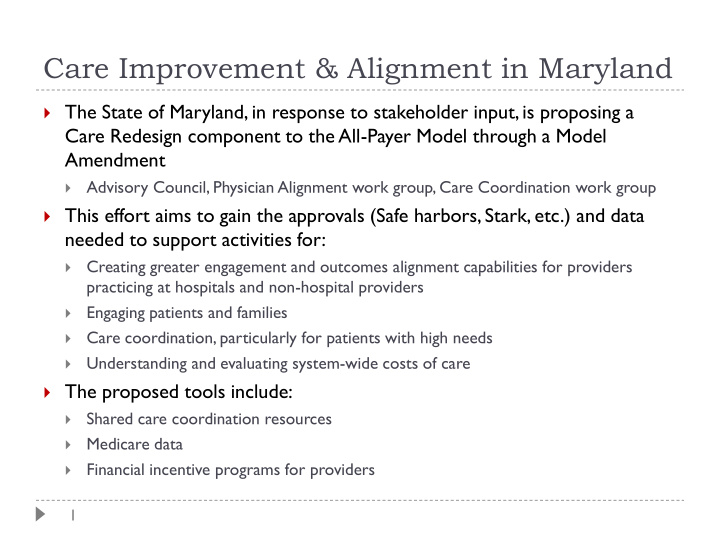



Care Improvement & Alignment in Maryland The State of Maryland, in response to stakeholder input, is proposing a Care Redesign component to the All-Payer Model through a Model Amendment Advisory Council, Physician Alignment work group, Care Coordination work group This effort aims to gain the approvals (Safe harbors, Stark, etc.) and data needed to support activities for: Creating greater engagement and outcomes alignment capabilities for providers practicing at hospitals and non-hospital providers Engaging patients and families Care coordination, particularly for patients with high needs Understanding and evaluating system-wide costs of care The proposed tools include: Shared care coordination resources Medicare data Financial incentive programs for providers 1
Update on Current Model Developments Hospital All-Payer Model Potential Progression: 2016 2017 2018 2019 2024 Future- Subject to Planning Process All-Payer Amendment + Complex & Chronic Care Further develop Hospital + Improvement Program (P4O) partnerships with + Long- Geographic providers, bring care term/ Non-Hospital Hospital Global + Hospital Care coordination to scale Post- Model (w/ Shared Improvement Program (ICS) for high needs, Acute Savings) complex, rising risk Models Model + Other Models patients Current efforts focused on strengthening & optimizing: Chronic care provider-patient relationship Care management for high needs & complex patients Care coordination among providers across care continuum 2 (Ideas Staff Developed and Collected From Stakeholders)
Two Potential New Programs: Creating Alignment Across Hospitals & Other Providers Hospital Care Complex and Chronic Care Improvement, or Internal Improvement, or Pay for Cost Savings (ICS), Program Outcomes (P4O), Program • Who? For providers practicing • Who? For community at hospitals providers • What? Designed to reward • What? Incentives for high- improvements in hospital care value activities focused on high that result in care improvements needs patients with complex and and efficiency rising needs, such as multiple chronic conditions Through these voluntary programs, hospitals would be able to share resources with providers, and potentially provide them incentive payments Quality targets must be met, costs should not shift, and the total cost of care should not rise above a benchmark 3
Complex and Chronic Care Improvement or Pay for Outcomes (P4O) Program A voluntary, alignment program that Allows hospitals to incentivize and support community providers in improving complex and chronic care, particularly for those patients who qualify for CMS’ CCM fee Ties resources from hospitals together with resources from Medicare payments to providers, essentially creating a chronic medical home for these high needs persons Joint efforts of Reductions in Improved hospitals and avoidable Greater savings Hospitals can quality and community hospital for hospitals share savings better under global with the providers to utilization (e.g. outcomes for improve complex readmissions, budgets providers patients and chronic care PQIs) “Pay for Outcomes” (P4O) 4
Complex and Chronic Care Improvement or Pay for Outcomes (P4O) Program (cont.) Hospitals would be able to: Make shared savings Share resources with payments to providers providers that support Assist providers in when they implement care these activities (e.g. care accessing Medicare’s CCM redesign activities that coordinators, advanced fee since P4O’s design result in reductions in practice nurses, etc.) in closely aligns with the CCM avoidable hospital utilization office-based and nursing requirements and better outcomes home settings Care redesign activities could include: Care management (e.g. using HRAs and creating care plans) Care coordination (e.g. obtaining discharge summary, updating records, reconciling medications) Community activities (e.g. services outside traditional office setting) 5
Next Steps for the Model Amendment Focus on gaining approvals from CMS Mid-summer target for Amendment Gain access to TCOC data for providers Vet detail plans with providers/all stakeholders Make adjustments as needed Preliminary plans for a 2017 program launch Maryland’s care redesign efforts help facilitate overall practice transformation towards person-centered care that produces better outcomes and improves quality of life Collectively focusing on outcomes will help us achieve those goals and also control and reduce the growth in total health care costs 6
Thoughts on Potential Intersection with Dual Eligible Initiatives P4O in its current form: Dual eligible patients’ providers (e.g. many of those in nursing homes) could participate in the program to receive resources, and potentially shared savings from hospitals in a future iteration Provider eligibility will be in line with the CMS Chronic Care Management (CCM) Fee Eligible providers include family practice, general or specialist physician who the patient designates as the primary provider of care, nurse midwives, clinical nurse specialists, nurse practitioners, and physician assistants P4O in the future: If the future duals model includes a shared savings component, the P4O program could be expanded to include savings for dual eligible patients across the system , combining resources and shared savings from hospitals, nursing homes, and other providers 7
Recommend
More recommend